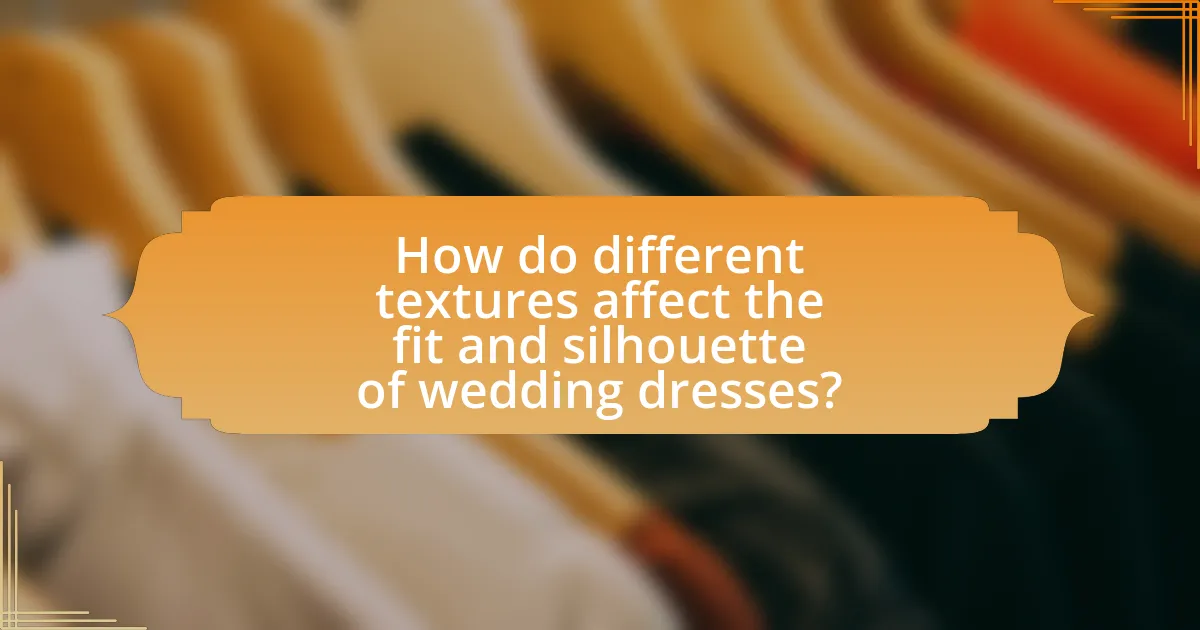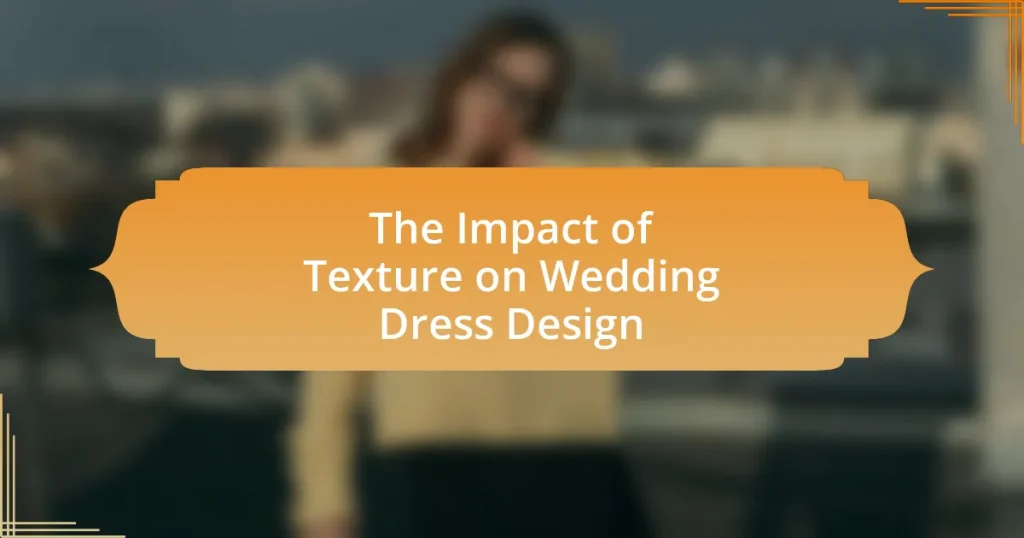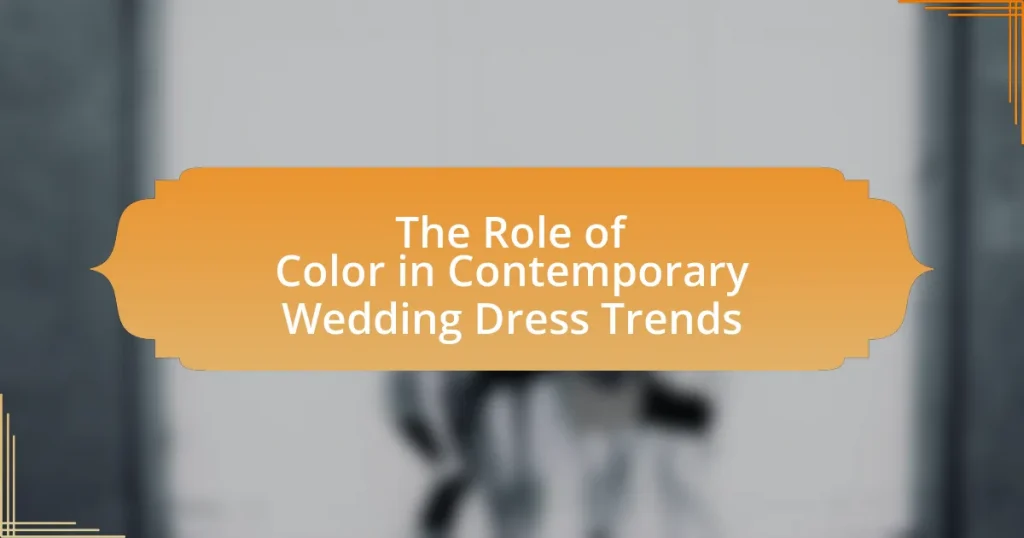The article examines the significant role of texture in wedding dress design, highlighting how various fabrics such as lace, satin, tulle, and chiffon influence the visual appeal, drape, and overall aesthetic of the gown. It discusses the impact of texture on comfort, movement, and the dress’s ability to reflect light, as well as current trends in bridal fashion. Additionally, the article addresses practical considerations for brides when selecting textures, including body type compatibility and maintenance challenges, ensuring that the chosen fabric aligns with both style and comfort needs.

What is the Impact of Texture on Wedding Dress Design?
Texture significantly influences wedding dress design by affecting the visual appeal, drape, and overall aesthetic of the garment. Different textures, such as lace, satin, tulle, and chiffon, create distinct looks and feelings; for instance, lace adds a romantic and vintage quality, while satin provides a sleek and modern appearance. The choice of texture also impacts how light interacts with the fabric, enhancing or softening the dress’s silhouette. Additionally, texture can influence the comfort and movement of the dress, as heavier fabrics may restrict movement while lighter materials allow for more fluidity. This interplay of texture and design elements is crucial in achieving the desired emotional response and style for the bride on her special day.
How does texture influence the overall aesthetic of a wedding dress?
Texture significantly influences the overall aesthetic of a wedding dress by affecting its visual appeal and tactile experience. Different textures, such as lace, satin, or tulle, create distinct looks and feelings; for instance, lace adds a romantic and vintage quality, while satin offers a sleek and modern appearance. The interplay of textures can enhance the dress’s design elements, such as volume and movement, contributing to the overall silhouette. Additionally, the choice of texture can evoke specific emotions and themes, aligning with the couple’s vision for their wedding. Studies in fashion design emphasize that texture is a critical component in creating a cohesive and impactful bridal look, as it can transform a simple design into a statement piece.
What are the different types of textures used in wedding dress fabrics?
Wedding dress fabrics feature various textures, including satin, lace, tulle, chiffon, organza, and mikado. Satin provides a smooth, luxurious finish, while lace adds intricate patterns and a romantic feel. Tulle is lightweight and airy, often used for skirts and veils, whereas chiffon offers a soft drape and flow. Organza is crisp and sheer, giving structure to designs, and mikado combines silk and nylon for a slightly heavier, luxurious texture. Each texture contributes uniquely to the overall aesthetic and design of the wedding dress, influencing its visual appeal and wearability.
How do textures affect the visual appeal of a wedding dress?
Textures significantly enhance the visual appeal of a wedding dress by adding depth, dimension, and interest to the overall design. Different textures, such as lace, satin, tulle, and chiffon, create varying visual effects; for instance, lace can introduce intricate patterns and a romantic feel, while satin offers a smooth, luxurious appearance. The interplay of textures can also influence how light interacts with the fabric, resulting in a dynamic look that changes with movement. Research indicates that textured fabrics can evoke emotional responses, making the dress more memorable and impactful for both the wearer and the guests.
Why is texture important in the context of wedding dress design?
Texture is important in wedding dress design because it significantly influences the overall aesthetic, feel, and visual impact of the gown. Different textures, such as lace, satin, or tulle, can create varying levels of elegance, romance, and sophistication, which are essential for a wedding setting. For instance, lace adds a delicate and vintage quality, while satin provides a smooth and luxurious appearance. The choice of texture also affects how light interacts with the fabric, enhancing the dress’s visual appeal through shadows and highlights. This interplay of texture and light can elevate the bride’s presence, making her stand out on her special day.
How does texture contribute to the bride’s comfort and movement?
Texture significantly contributes to the bride’s comfort and movement by influencing the fit and flexibility of the wedding dress. Fabrics with a soft, smooth texture, such as silk or chiffon, allow for greater ease of movement, reducing friction against the skin and enhancing overall comfort. In contrast, stiffer materials may restrict movement and cause discomfort. Research indicates that the choice of fabric texture can affect how a garment drapes and moves with the body, which is crucial for activities like walking, dancing, and sitting during the wedding. Therefore, selecting the right texture is essential for ensuring that the bride feels comfortable and can move freely throughout her special day.
What role does texture play in the dress’s ability to reflect light?
Texture significantly influences a dress’s ability to reflect light. Different textures, such as smooth, matte, or shiny surfaces, interact with light in distinct ways, affecting how much light is absorbed or reflected. For instance, a satin fabric, characterized by its smooth and glossy surface, reflects more light than a textured fabric like lace, which diffuses light due to its uneven surface. This interaction can enhance the visual appeal of the dress, creating a dynamic appearance that changes with movement and lighting conditions. Studies in textile science indicate that the surface structure of fabrics plays a crucial role in determining their reflective properties, confirming that texture is a key factor in light reflection for dresses.
What are the current trends in wedding dress textures?
Current trends in wedding dress textures include the use of lightweight fabrics, intricate lace, and 3D floral appliqués. Lightweight fabrics such as chiffon and tulle are favored for their ethereal quality, allowing for movement and comfort. Intricate lace remains popular, often used in layering to create depth and visual interest. Additionally, 3D floral appliqués are increasingly incorporated into designs, adding a tactile element that enhances the overall aesthetic. These trends reflect a shift towards a more romantic and personalized approach to wedding attire, catering to modern brides’ preferences for both elegance and individuality.
How have modern designers incorporated texture into their collections?
Modern designers have incorporated texture into their collections by utilizing a variety of materials and techniques that enhance visual and tactile appeal. For instance, designers often blend fabrics such as lace, tulle, and satin to create layered effects that add depth and dimension to wedding dresses. Additionally, techniques like embroidery, beading, and appliqué are frequently employed to introduce intricate textures that catch the light and draw attention. This approach not only elevates the aesthetic quality of the garments but also allows for personalization, as textures can convey different themes and emotions, aligning with contemporary bridal trends that favor unique and expressive designs.
What textures are gaining popularity among brides today?
Lace, tulle, and satin are gaining popularity among brides today. Lace offers a romantic and vintage aesthetic, while tulle provides a light and airy feel, often used in skirts and overlays. Satin, known for its luxurious sheen, is favored for its smooth texture and elegant drape. These textures are increasingly chosen for their ability to enhance the overall design and visual appeal of wedding dresses, reflecting current trends in bridal fashion.

How do different textures affect the fit and silhouette of wedding dresses?
Different textures significantly influence the fit and silhouette of wedding dresses by altering how the fabric drapes and shapes the body. For instance, structured fabrics like satin and taffeta create a more defined silhouette, enhancing the shape of the gown and providing support, which is ideal for ball gowns or A-line styles. In contrast, softer textures such as chiffon and lace tend to flow more freely, resulting in a softer, more romantic silhouette that can create an ethereal look.
Additionally, the weight and thickness of the fabric play a crucial role; heavier materials can add volume and structure, while lighter fabrics can lead to a more relaxed fit. According to a study published in the Journal of Fashion Technology & Textile Engineering, the choice of fabric texture directly impacts the garment’s drape and fit, confirming that texture is a key factor in wedding dress design.
What textures are best suited for various body types?
Silk and satin textures are best suited for hourglass body types, as they drape elegantly and highlight curves. For pear-shaped body types, A-line dresses with lace or chiffon textures create balance by adding volume to the upper body while skimming over the hips. Athletic body types benefit from textured fabrics like tulle or organza, which add softness and femininity, enhancing the overall silhouette. Lastly, for plus-size body types, heavier fabrics such as brocade or structured lace provide support and shape, ensuring a flattering fit. These recommendations are based on the principles of body shape styling, which emphasize the importance of texture in enhancing or balancing body proportions.
How does the weight of a fabric influence the dress’s silhouette?
The weight of a fabric significantly influences a dress’s silhouette by determining how the material drapes and holds shape. Heavier fabrics, such as satin or brocade, create structured silhouettes that maintain form and provide a more defined shape, often enhancing features like the waistline or creating a voluminous skirt. In contrast, lighter fabrics like chiffon or tulle tend to flow more freely, resulting in softer, more ethereal silhouettes that can appear less structured and more romantic. This relationship between fabric weight and silhouette is crucial in wedding dress design, as it affects not only the aesthetic but also the overall comfort and movement of the wearer.
What are the implications of texture on the dress’s draping and flow?
Texture significantly influences a dress’s draping and flow by affecting how the fabric interacts with gravity and movement. For instance, heavier textures like brocade or velvet create structured silhouettes that maintain their shape, while lighter textures such as chiffon or organza allow for a more fluid and ethereal drape. The choice of texture can also impact the way light reflects off the fabric, enhancing or diminishing the visual flow of the dress. Research indicates that the draping characteristics of fabrics are determined by their weight, stiffness, and surface finish, which collectively dictate how the material falls and moves with the wearer.
How can texture enhance or detract from a wedding dress’s design?
Texture can significantly enhance or detract from a wedding dress’s design by influencing its visual appeal and tactile experience. For instance, intricate lace can add elegance and depth, creating a romantic aesthetic, while overly heavy or coarse fabrics may overwhelm the silhouette and detract from the overall look. Studies in fashion design indicate that texture affects perception; smooth fabrics often convey sophistication, while rough textures can evoke a more casual feel. Therefore, the choice of texture directly impacts the dress’s ability to convey the desired emotional tone and style for the wedding.
What are the potential challenges of using certain textures in wedding dress design?
Using certain textures in wedding dress design can present challenges such as difficulty in achieving the desired silhouette, potential discomfort for the wearer, and complications in maintenance. For instance, heavy fabrics like brocade may not drape as fluidly as lighter materials, which can hinder the overall fit and movement of the dress. Additionally, textured fabrics such as lace or tulle can be less forgiving on the skin, leading to irritation or discomfort during long wear. Maintenance issues arise as well; intricate textures often require specialized cleaning methods, making them less practical for brides concerned about upkeep. These factors highlight the importance of careful consideration when selecting textures for wedding dresses.
How can designers balance texture with other design elements?
Designers can balance texture with other design elements by strategically combining various materials and patterns to create visual harmony. For instance, a designer might use a heavily textured fabric, such as lace, alongside smoother materials like satin to provide contrast while ensuring that the overall aesthetic remains cohesive. This approach is supported by the principle of design balance, which emphasizes the importance of proportion and variety in creating an appealing composition. By carefully selecting textures that complement each other, designers can enhance the visual interest of a wedding dress without overwhelming the viewer.

What practical considerations should brides keep in mind regarding texture?
Brides should consider the fabric texture of their wedding dress as it affects comfort, style, and overall appearance. Different textures, such as lace, satin, or tulle, can influence how the dress drapes and moves, impacting the bride’s comfort throughout the event. For instance, heavier fabrics may provide structure but can be less breathable, while lighter materials may enhance mobility but lack support. Additionally, the texture can affect the dress’s visual appeal; intricate textures can add depth and interest, while simpler textures may create a more classic look. Understanding these factors helps brides select a dress that aligns with their personal style and the practicalities of their wedding day.
How can brides choose the right texture for their wedding dress?
Brides can choose the right texture for their wedding dress by considering their body type, the season, and the overall theme of the wedding. For instance, lightweight fabrics like chiffon or organza are ideal for summer weddings, while heavier materials such as satin or taffeta suit winter ceremonies. Additionally, brides should assess how different textures complement their skin tone and personal style; lace adds a romantic touch, while sleek silk offers modern elegance. Research indicates that the right texture can enhance the overall aesthetic and comfort of the dress, making it crucial for brides to try on various fabrics to see how they feel and look in different lighting conditions.
What factors should be considered when selecting fabric textures?
When selecting fabric textures for wedding dress design, key factors include the drape, weight, and feel of the fabric. Drape affects how the fabric falls and moves, influencing the overall silhouette of the dress; for instance, heavier fabrics like satin create structured shapes, while lighter fabrics like chiffon offer a flowy appearance. Weight is crucial as it determines comfort and suitability for different seasons; heavier fabrics are ideal for cooler weather, while lighter options are better for warmer climates. The feel of the fabric impacts the wearer’s comfort and the visual appeal; soft textures like silk provide a luxurious touch, while textured fabrics like lace add dimension and interest. These factors collectively influence the aesthetic and functional aspects of the wedding dress, ensuring it meets the bride’s vision and comfort needs.
How can brides ensure comfort without sacrificing style?
Brides can ensure comfort without sacrificing style by selecting wedding dresses made from breathable fabrics and incorporating flexible designs. Breathable materials like chiffon, silk, and lightweight lace allow for airflow, reducing discomfort during long events. Additionally, styles that feature adjustable elements, such as corset backs or removable layers, provide both comfort and the ability to maintain a fashionable appearance. Research indicates that the right fabric choice significantly impacts overall comfort, as seen in studies highlighting the importance of texture in garment design, which can enhance wearability while still being visually appealing.
What are some tips for maintaining the texture of a wedding dress?
To maintain the texture of a wedding dress, it is essential to store it properly, clean it gently, and handle it with care. Storing the dress in a cool, dry place, preferably in a breathable garment bag, prevents moisture and dust accumulation that can damage delicate fabrics. Gentle cleaning methods, such as spot cleaning with a mild detergent or professional dry cleaning, help preserve the fabric’s integrity without causing wear. Additionally, handling the dress with clean hands and avoiding contact with rough surfaces minimizes the risk of snagging or tearing, ensuring the texture remains intact.
How should different textures be cleaned and preserved after the wedding?
Different textures in wedding dresses should be cleaned and preserved according to their specific material properties. For example, silk should be dry cleaned to avoid water stains, while lace can be gently hand washed in cold water with mild detergent to maintain its delicate structure. Beaded or sequined textures require careful handling; they should be dry cleaned to prevent damage to embellishments. After cleaning, all textures should be stored in breathable garment bags, away from direct sunlight, to prevent discoloration and degradation. Proper preservation techniques, such as acid-free tissue paper for layering and avoiding folding, help maintain the integrity of the textures over time.
What common issues arise with textured fabrics, and how can they be addressed?
Common issues with textured fabrics include snagging, difficulty in cleaning, and uneven wear. Snagging occurs due to the raised fibers catching on objects, which can be mitigated by using protective linings or choosing fabrics with tighter weaves. Cleaning challenges arise because textured surfaces can trap dirt and stains; this can be addressed by following specific care instructions and using appropriate cleaning agents designed for delicate fabrics. Uneven wear often results from the fabric’s structure, leading to visible fading or fraying; rotating the garment during wear and proper storage can help maintain the fabric’s integrity.



